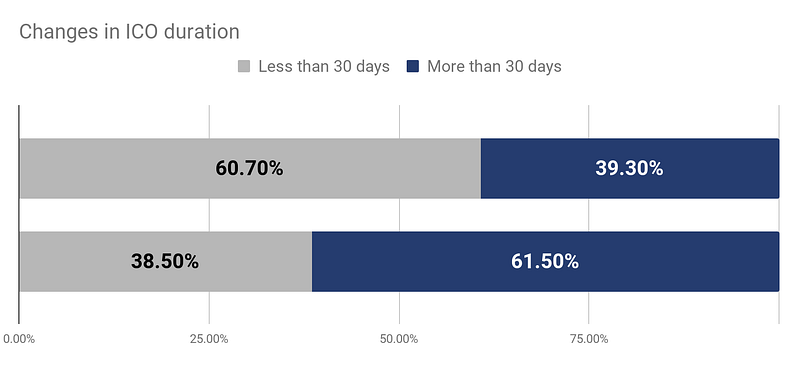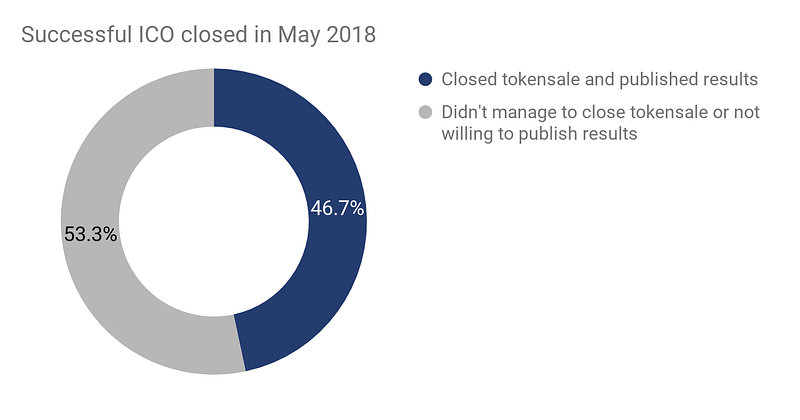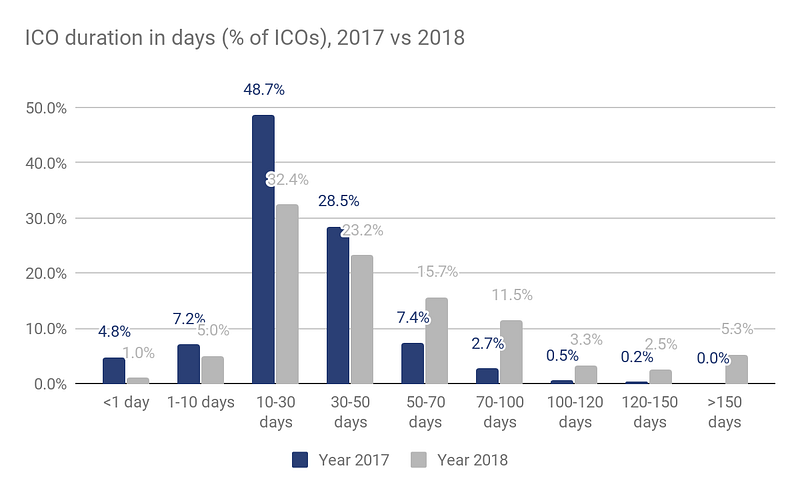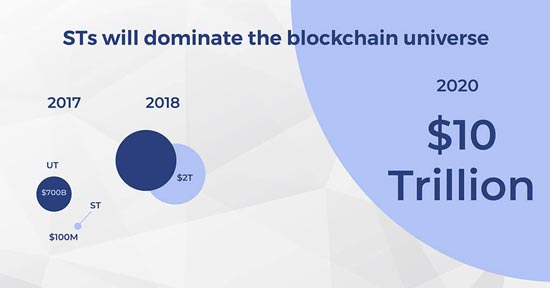Every month more than 300 ICOs are listed on ICObazaar. In May 91 ICOs closed public sales raising $ 2,5 bln. In Part 1 we give data on the main trends of ICO process: duration increases and more funds are coming from private and pre-sales. Part 2 is an overview of emerging fundraising methods, marketing and legal aspects.
Part 1. ICO Market key trends of 2017–2018
Less than half of declared tokensales report reaching goals
In 2017 according to TokenData and FabricVentures report from 913 projects that had tokensale, only 435 (48%) were successful raising $5,6 bln. 131 (14%) didn’t survive this stage 347 (38%) ICOs stayed unreported with no data displayed and even websites disappearing. As a result — low trust to blockchain industry.
In 2018 the hype is over. Less startups assume they need an ICO and industry tends to get realistic. Laws and regulations are emerging, everything tends to come in order to protect investors and give project teams a more powerful foothold for development.
In May 2018 there were 195 ongoing ICOs on ICObazaar planning to close sales. In fact only 91 public sales were closed with $ 2 566 588 843 raised.
The average duration of projects in May 2018 was 42 days. While 51% of ICOs prefer to close token sale within one month, others tend to organize longer sales in several stages.

Source: Icobazaar.com
In May 2018 195 projects planned to close coinsale and only 91 did.

Source: Icobazaar.com
ICO duration increases
In 2017 60% of all projects planned ICO to last less than a month. In 2018 61% of ICOs are planned for 30+ days and divided it into 3+ stages with different discount programs. 10% of ICO last more than 3 month (public sales only).

Source: ICOBazaar
In 2018 the duration of projects significantly increases. If in 2017 only 39% planned to sale coins for more than a month, in 2018 61,5% act this way. More and more teams initially lay pre-ICO, and then 3 or more stages of sales. In the conditions of substantially increased competition the duration of marketing preparations increases. Also considering examples of extremely successful super long ICO (like EOS) more projects choose to extend ICO.
More projects start with private sale
Today it becomes a standard to conduct private sale before public sale. Nearly 30–35% of tokens with large discount (up to 50%) will go to crypto funds and angel investors. Projects use the money to fund pre-ICO campaign including marketing and social media advertising.
Data shows that 84% of all ICO fundraising this year has come from private and presales.
Pre-ICO allows to check test the product idea, get community feedback and gain awareness and interest without spending money on a full-scale promotion. On a pre-ICO a project can raise $2–3 mln and be ready to go worldwide.
Part 2. Emerging fundraising methods, changes in marketing and legal
New fundraising forms: STO, DAICO, IICO, CTM
More and more market players admit that the title “ICO” itself is compromised. While part of the projects leans toward STO, others prefer new forms of crypto crowd sales like DAICO, Interactive Coin Offering or Continuous Token Models.
Security Token Offering (STO) is held when token is backed by real assets or profits or company revenue. These tokens are protected from speculations and scammers, more like a traditional security, but in electronic form. Moreover, such a token meets all requirements of the U.S. Securities and Exchange Commission (SEC), which allows it to completely legally implement the token sale in the USA. The first security token platform Polymath data shows that STO will prevail on the market by 2020 and will be more than $10 trl.

(Source: Polymath, 2018)
DAICO is a hybrid solution of ICO and DAO, a model that allows the company to attract a solid investment, but at the same time provide investors with certain levers of management. It was Ethereum founder Vitalik Buterin who suggested this modification in order to improve ICO processing.
Interactive Coin Offerings is a protocol from creators Jason Teutsch and Vitalik Buterin that suggests a slightly different model of crowdsale that ensures certainty of valuation and participation at the same time. Dynamic mechanism then determines the desired number of purchases for each valuation, which leads to the final price that must satisfy both goals.
Continuous Token Models assumes that “instead of pre-selling tokens during a launch phase, the tokens are minted as needed through various means. The tokens are then dispensed for services rendered in the network”. Such continuous token models could enable small issuer specific bounty networks as well as an ongoing generation of non-fungible assets.
The idea is not enough, the product matters
In 2018 a steep roof-like idea does not automatically mean success anymore. “Game-changing” or “decentralising everything” is not the key. The product should meet industry demands, be scalable and integrative. The team must be strong and experienced, have notable advisors onboard and and a clear vision on funds spendings proved by a clear roadmap. Can I see the code on Github? No? Next!
Legal and Marketing
If in 2017 it was possible to start an ICO without hiring a lawyer, today more and more projects will undergo regulation and issue security-tokens, which involves the payment of dividends/profit share. This is a simple and understandable model, attractive for most investors, especially for traditional investment natives.
Due to the fact that 80% of the money now comes from large investors, it is not necessary to spend hundreds of thousands on your lending traffic, if you can more accurately work with large investors and funds. Moreover, the cost of buying traffic and publications grows even faster than the rate of some crypto-currencies.
The cost of conducting ICO, purchasing traffic and promotion on ICO trackers grows every month. Experts say that if in September 2017 it was possible to arrange an ICO for $60 thousand, in 2018 it costs at least $125 thousand. It becomes more difficult to attract investors, an increasingly important role is played by team personal participation in the promotion of the project and personal communication with major investors.
Summary
The current crowdsale model is still at the very beginning of its development and will face a large number of changes that will be bring more transparency, reliability and security, both to investors and projects themselves.
New forms of token offering are emerging, allowing projects to receive funds for the development of new ideas. Analysts compare today’s processes with the development of the Internet in 2000, the industry is starting to seek solutions to the real business tasks, more and more projects tend to register security tokens, as connecting your virtual token to real token is an additional confirmation of reliability for the user.
Even in a high-tech industry like the token market, no one has abolished natural selection — those who can build more proactive management and will be more effective in their work will survive. Given that at the moment more than half of the projects do not reach the set goal for fund-raising, it is obvious that there remains a huge field for improvements.
About ICObazaar:
ICObazaar.com is one of the leading ICO trackers providing independent rating and reviews of trending ICOs since 2017. ICO listed database is 3000+ projects with over $ 1 bln raised.
ICOBazaar gives access to 120 000 active investors offering diverse marketing options for ICO owners.
This is a sponsored press release and does not necessarily reflect the opinions or views held by any employees of NullTX. This is not investment, trading, or gambling advice. Always conduct your own independent research.